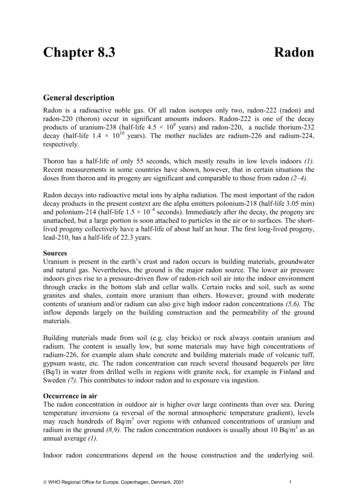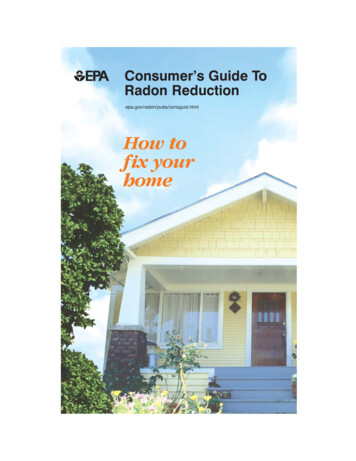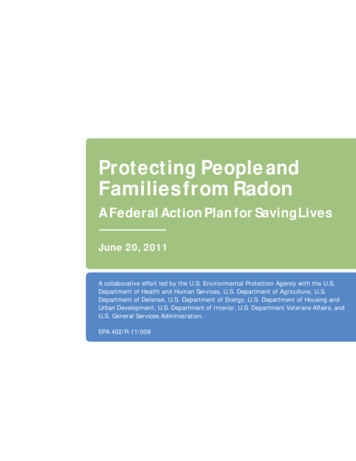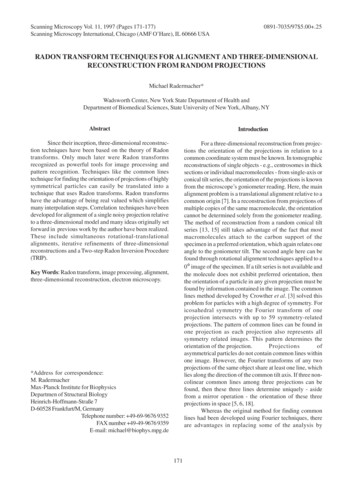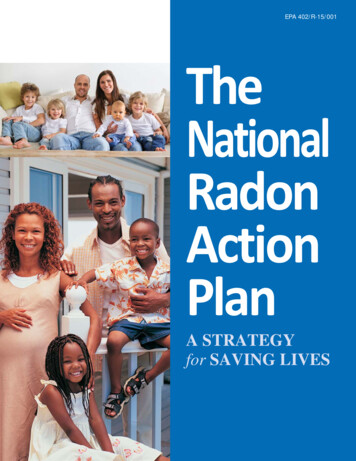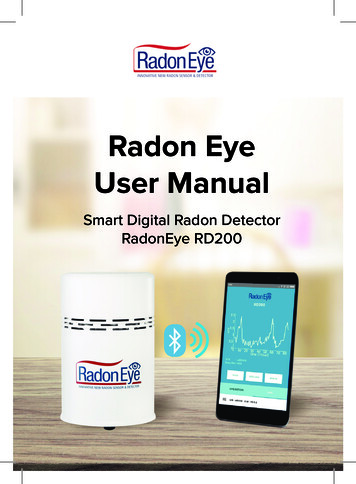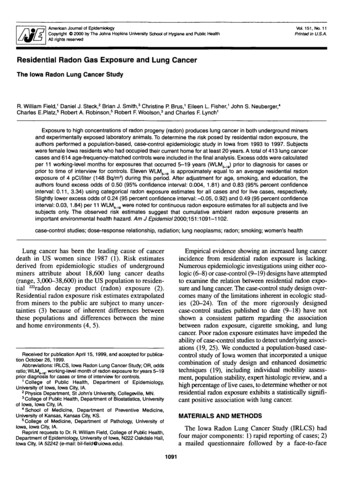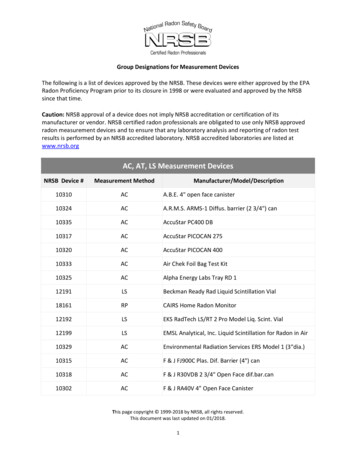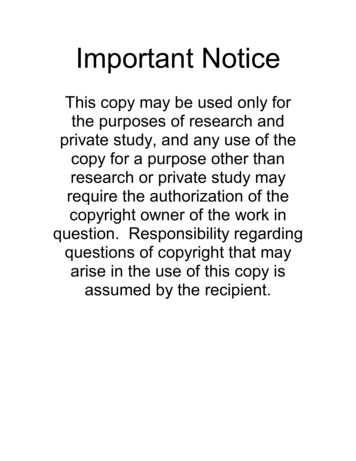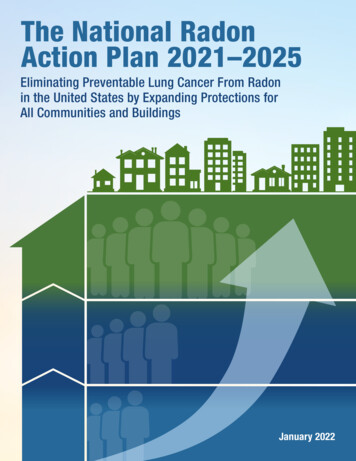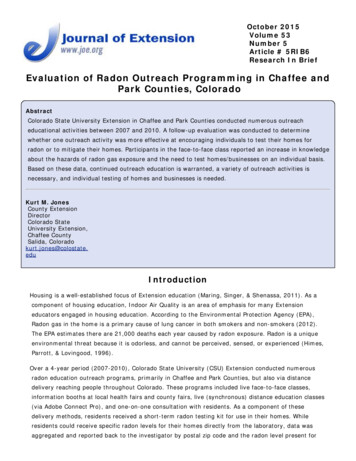
Transcription
October 2015Volume 53Number 5Article # 5RIB6Research In BriefEvaluation of Radon Outreach Programming in Chaffee andPark Counties, ColoradoAbstractColorado State University Extension in Chaffee and Park Counties conducted numerous outreacheducational activities between 2007 and 2010. A follow-up evaluation was conducted to determinewhether one outreach activity was more effective at encouraging individuals to test their homes forradon or to mitigate their homes. Participants in the face-to-face class reported an increase in knowledgeabout the hazards of radon gas exposure and the need to test homes/businesses on an individual basis.Based on these data, continued outreach education is warranted, a variety of outreach activities isnecessary, and individual testing of homes and businesses is needed.Kurt M. JonesCounty ExtensionDirectorColorado StateUniversity Extension,Chaffee CountySalida, g is a well-established focus of Extension education (Maring, Singer, & Shenassa, 2011). As acomponent of housing education, Indoor Air Quality is an area of emphasis for many Extensioneducators engaged in housing education. According to the Environmental Protection Agency (EPA),Radon gas in the home is a primary cause of lung cancer in both smokers and non-smokers (2012).The EPA estimates there are 21,000 deaths each year caused by radon exposure. Radon is a uniqueenvironmental threat because it is odorless, and cannot be perceived, sensed, or experienced (Himes,Parrott, & Lovingood, 1996).Over a 4-year period (2007-2010), Colorado State University (CSU) Extension conducted numerousradon education outreach programs, primarily in Chaffee and Park Counties, but also via distancedelivery reaching people throughout Colorado. These programs included live face-to-face classes,information booths at local health fairs and county fairs, live (synchronous) distance education classes(via Adobe Connect Pro), and one-on-one consultation with residents. As a component of thesedelivery methods, residents received a short-term radon testing kit for use in their homes. Whileresidents could receive specific radon levels for their homes directly from the laboratory, data wasaggregated and reported back to the investigator by postal zip code and the radon level present for
Research in BriefEvaluation of Radon Outreach Programming in Chaffee and Park Counties, ColoradoJOE 53(5)each unique kit number.A follow-up evaluation was conducted in 2010 to determine whether one outreach activity was moreeffective at encouraging individuals to test their homes for radon or to mitigate their homes. Thefollow-up evaluation sought to determine prevalence of elevated radon levels as evidence forcontinued programming and whether one outreach educational program was more effective thanothers for knowledge gained, behavior change (change in short-term testing of homes), or conditionchanges (homes mitigated to reduce radon levels).MethodologyThe radon program participants who completed a short-term radon test on their home or businesswere selected as the target population. In August, 2010, permission was received from CSU InternalReview Board to conduct a follow-up survey of clients who had submitted their short-term radontesting kits for analysis to the laboratory. Mailing addresses were provided by the laboratory to CSUExtension. Of the 330 addresses provided, 230 surveys were mailed. Participants were selected viasystematic random sampling of the non-alphabetized mailing list. Four of the addresses were left outbecause they were from out-of-state addresses. There were 22 surveys that were returned unusable(incorrect mailing address, new residents, and blank surveys returned). The response rate for thesurveys was 103 of the original 230 surveys sent (45%).During the same time period (2007-2010), CSU Extension received short-term radon testing resultsbased on postal zip codes. Individual households were not able to be identified by these reportsgenerated by the laboratory. The monthly reports were compiled and analyzed below.Statistical analysis was conducted using IBM SPSS, 2012 edition. Statistics tests used includedWilcoxen Signed Ranks, Pearson correlations, Chronbach's alpha, and simultaneous multipleregression based on the prescribed evaluation. Specific tests are described in more detail below. Effectsizes, where applicable, were hand-calculated using the protocols outlined in Morgan, Leech,Gloeckner, and Barrett (2011). Research validity discussion (in the Discussion section) used theprotocol outlined in Gliner, Morgan, and Leech (2009), with emphasis on external validity, internalvalidity, and measurement validity.Knowledge-gained questions were designed as a "post-then-pre" selection where participants wereasked after the class what their knowledge was pre-class and post-class. An example of the type ofLikert-scale question is presented in Figure 1.Figure 1.Example of Likert-Scale QuestionPlease describe your level of knowledge about the hazards of indoor radonexposure prior to attending the class or information booth.12345No KnowledgeMinimalModerateAdvancedExpertPlease describe your level of knowledge about the hazards of indoor radon 2015 Extension Journal Inc.1
Research in BriefEvaluation of Radon Outreach Programming in Chaffee and Park Counties, ColoradoJOE 53(5)exposure after attending the class or information booth.12345No KnowledgeMinimalModerateAdvancedExpertResultsMuch of Colorado has the potential for elevated radon levels in the home (EPA, 2012), and the testingresults show this to be true in Chaffee, Park and surrounding counties (Table 1). Using summarizeddata as a predictor for individual residents is not recommended because some properties have greatlyelevated radon reading (e.g., Salida skewness 7.81). Each home should be individually tested forradon levels, and those exhibiting levels above 4.0 pCi/L should be evaluated for mitigation (EPA,2012).Table 1.Short-Term Testing Results for Radon in and Around Chaffee CountyStd.LocationNStd.Minimum Maximum Mean Deviation Median1 Skewness ErrorSalida222.3198.710.2716.836.257.81.163Buena Neighboring3 11Misc. State4341Median is reported for areas where skewness exceeds 1.0 as measure of central tendency.2Park County includes all zip codes within Park County, Colorado. None of the areasexceeded 10 kits per zip code, so they were all combined to maintain confidentiality.3Neighboring Counties to either Chaffee or Park County.4Kits from Colorado Zip Codes not included in any other area.In order to quantify whether Chaffee County residents have the potential for elevated radon levels intheir homes, short-term radon testing results were compared against the EPA action level of 4.0 pCi/L.Due to the skewness of the results of the short-term tests, the parametric one-sample t-test was not 2015 Extension Journal Inc.2
Research in BriefEvaluation of Radon Outreach Programming in Chaffee and Park Counties, ColoradoJOE 53(5)used. Instead, the nonparametric Wilcoxen Signed Ranks test was used against the EPA action level.Each of the four locations in Chaffee County (Table 2) showed statistical significance for havingelevated radon levels. Park County locations were not considered in this analysis due to the low returnrate of testing kits for each postal zip code and the researcher's desire to protect anonymity.Table 2.Ranksa and Statistics for EPA Action Level (4.0 pCi/L) and Selected ChaffeeCounty LocationsMeanVariablesNEPA Action Level Salida (High Tests)147Rank133.61Z7.75bp .001EPA Action Level Salida (Low Tests)EPA Action Level Salida7466.091Total Salida222EPA Action Level Buena Vista (High Tests)3936.364.02b .001EPA Action Level Buena Vista (Low Tests)EPA Action Level Buena VistaTotal Buena VistaEPA Action Level Poncha Springs (High2017.6005999.3354.201.98b.0483.75b Tests)EPA Action Level Poncha Springs (LowTests)EPA Action Level Poncha Springs0Total Poncha Springs14EPA Action Level Nathrop (High Tests)2012.10.001EPA Action Level Nathrop (Low Tests)2EPA Action Level Nathrop0Total Nathrop5.5022a Wilcoxon Signed Ranks Testb Based on High Tests 2015 Extension Journal Inc.3
Research in BriefEvaluation of Radon Outreach Programming in Chaffee and Park Counties, ColoradoJOE 53(5)Results from the mailed surveys offered some evidence of knowledge gain and behavior change. Usinga five-point Likert scale, respondents reported a pre-class knowledge of the hazards of radon at amean of 2.24 and post-class knowledge at a mean of 3.49 (n 99). They also reported a pre-classknowledge of the importance of testing at a mean of 2.21 and a post-class knowledge at a mean of3.69. Of note, respondents reported an indication of behavior change, as evidenced that 18% hadtested for radon prior to the class and 95% reported testing after the class. Perhaps the mostencouraging result was that 25% of the respondents had installed a radon mitigation system in theirhomes (n 100). Respondents reported that they attended a live class (51%), participated in theonline class (8%), visited the educational booth (24%), and/or followed up with one-on-oneconsultation (28%). There were some that used more than one educational event.Each of the four variables were normally distributed (Table 3), and the assumption of linearity was notmarkedly violated. Pearson correlations were computed to examine the intervariable correlations.Table 3 shows that the four pairs were significantly correlated, even with the Bonferroni correctiontaken into account (p .05/8 .00625). Two correlates (PreHazard/PreTest andPostHazard/PostTest) are of practical importance. To test instrument reliability, Chronbach's alpha wasconducted for the four variables (.77) and for the Pre-Class variables (.82) and Post Class variables(.83). Each of these alphas are considered sufficient (above .70, Morgan et al., 2011).Table 3.Intercorrelations, Means, Standard Deviations, and Skewness for Evaluation Variables (N 99)KnowVariableKnowKnowKnowPreHazard PostHazard PreTest PostTest Mean SD 8-.31Statistical Significance: *p .001 **p .002 ***p .004The strongest correlations (Table 3) are between the Pre-Course Knowledge of Hazards and Testingr(97) .70, p .001 and the Post Course Knowledge of Hazards and Testing r(97) .72, p .001,with an effect size considered larger than typical for each correlation. This is an indication of theefficacy of the outreach programming, but also suggests the need for Extension educators to provideradon outreach programming based on the knowledge reported prior to participating in the class.DiscussionThe survey instrument was created to gather feedback from participants in one of four radon educationoutreach venues: live class, distance education class, education booths at local events, and one-onone consultation. To determine research validity, the following are offered for external validity, internalvalidity, and measurement validity. 2015 Extension Journal Inc.4
Research in BriefEvaluation of Radon Outreach Programming in Chaffee and Park Counties, ColoradoJOE 53(5)External validity refers to the characteristics of the participants in the evaluation and the environmentin which they were surveyed. The radon program participants who completed a short-term radon teston their home or business were selected as the target population. Of those radon kits returned overthe 4-year period, there were 330 unique addresses generated. Evaluation funding for the programpermitted the surveying of 230 addresses. How participants were chosen was discussed in themethodology section. The population is considered medium-high due to the relatively low 45%response rate. It is not believed that this response rate introduced sampling bias, but a higherresponse rate was anticipated.The setting where the evaluation takes place can affect the results. Having as close to a "natural"setting is preferable. Participants were able to complete the survey instrument in their homes, each ofthe participants had previously had contact with the evaluator, and the importance of the subject ofthe program, the ecological assessment is considered high.One of the challenges of the survey instrument was the lack of demographic data collected. Due to thepotential sensitivity of disclosure of elevated radon testing results, this information was not soughtfrom respondents. Because of this, there was no ability to test subgroups such as age, gender,ethnicity, or location to further determine validity, rating for this is low. Overall external validity israted as medium.Follow-up evaluations of educational programs can often suffer from internal validity measurements. Inthe study reported here, there was no assignment of participants into experimental groups and nopretesting of a sub-cohort, and the study was not conducted in a controlled environment. In anattempt to improve these inherent characteristics, the survey instrument was evaluated by subjectmatter experts during development, and the relatively large sample size helps to alleviate theextraneous variables. Internal validity would be considered low to medium.Evidence of instrument validity and reliability was previously discussed in the results section incorresponding areas. Where appropriate, effect sizes were calculated and discussed. Measurementreliability would be considered medium to high. Based on these factors, overall evaluation validity isconsidered medium or typical for post-course evaluation designs.ImplicationsOne of the highlights of this evaluation and its results is outlined in Table 3. There was statisticallysignificant evidence of knowledge gained as reported by the participants' knowledge of the hazards ofradon gas prior to their participating in the class, and their knowledge of hazards following the class (r .44, p .001). This indicates that participants were generally unknowledgeable about the hazardsof radon exposure before the class, but were knowledgeable following the class. This is also the casewith testing for radon. There was statistical significance of the participants' knowledge of testing forradon gas prior to their participating in the class and their knowledge of testing following the class (r .29, p .004). This indicates that participants were generally unknowledgeable about testing forradon exposure before the class, but were knowledgeable following the class. Because these wereoverriding goals of the program, these results are practically significant and indicate that additionalradon outreach programs are warranted in the future. 2015 Extension Journal Inc.5
Research in BriefEvaluation of Radon Outreach Programming in Chaffee and Park Counties, ColoradoJOE 53(5)Also of interest is the radon testing results as reported by postal zip code (Tables 1 and 2). Table 2indicates the statistical potential for a residence to experience elevated radon levels, though the rangecan vary tremendously (Table 1). Due to the varying nature of radon levels in the home, individualresidences should be tested to determine their unique radon levels.One of the research questions that the evaluation failed to show was the effect of the various outreachactivities on the incidence of home mitigation. Simultaneous multiple regression was conducted toinvestigate whether multiple outreach activities could affect the incidence of home mitigation. It wasthought that participants who participated in an outreach class who also followed up with one-on-oneconsultation would have increased their incidence of home mitigation system installation, but this wasnot the case. The combination of variables to predict home mitigation from outreach activities was notstatistically significant, F(4,81) 1.66, p .168. The individual consultation was close to statisticallysignificant (β .30, t 1.92, p .058), perhaps suggesting that individuals were more likely to seekone-on-one consultation prior to investing their money into an active home mitigation system.One of the demographic questions that should have been included on the survey instrument was forrespondents to indicate the radon level of their home. Low radon readings would negate the need tomitigate the residence, but this data was unavailable. Another important extraneous variable affectingthe incidence of radon mitigation system installation is the relatively high cost for professionalinstallation. Some respondents may have chosen not to mitigate their homes due to the high cost,especially if their home radon test was only marginally elevated.ConclusionRadon outreach programming will continue to be an important topic for many residents. According tothe EPA, it is the number 2 cause of lung cancer in the United States, second only to cigarettesmoking. Extension is in a unique position to provide unbiased, research-based information andeducation on this important environmental hazard. The work is also quite rewarding, evidenced byknowledge gained (hazards of radon exposure and need for testing), behavior changes (routine radontesting), and ultimately reduced environmental hazards in the home (installation of active radonmitigation systems where warranted). Presented from a "Logic Model" viewpoint, for a relativelyminimal investment of outputs, there are easily documented short-term (knowledge gain), mediumterm (behavior change), and long-term (condition) changes in the program participants. In the wordsof a survey respondent, "You are wonderful, you safe lives!"ReferencesEnvironmental Protection Agency. (2012). A citizen's guide to radon. Retrieved verviewGliner, J. A., Morgan, G. A., & Leech, N. L. (2009). Research methods in applied settings: Anintegreated approach to design and analysis, 2nd edition. New York: Routledge Taylor and FrancisGroupHimes, L., Parrott, K., & Lovingood, R. (1996). The radon project: A study in environmental hazardeducation. Journal of Extension, 34(3) Article 3RIB2. Available at: 2015 Extension Journal Inc.6
http://www.joe.org/joe/1996june/rb2.phpMaring, E. F., Singer, B. J., & Shenassa, E. (2011). Healthy homes: A contemporary initiative forExtension education. Journal of Extension [On-line], 49(2) Article 2FEA9. Available at:http://www.joe.org/joe/2011april/a9.phpMorgan, G. A., Leech, N. L., Gloeckner, G. W., & Barrett, K. C. (2011). IBM SPSS for IntroductoryStatistics: Use and Interpretation, 4th Edition. New York: Routledge Taylor and Francis Group.Copyright by Extension Journal, Inc. ISSN 1077-5315. Articles appearing in the Journal become theproperty of the Journal. Single copies of articles may be reproduced in electronic or print form for usein educational or training activities. Inclusion of articles in other publications, electronic sources, orsystematic large-scale distribution may be done only with prior electronic or written permission of theJournal Editorial Office, joe-ed@joe.org.If you have difficulties viewing or printing this page, please contact JOE Technical Support
Colorado State University Extension in Chaffee and Park Counties conducted numerous outreach educational activities between 2007 and 2010. A follow-up evaluation was conducted to determine whether one outreach activity was more effective at encouraging individuals to test their homes for
